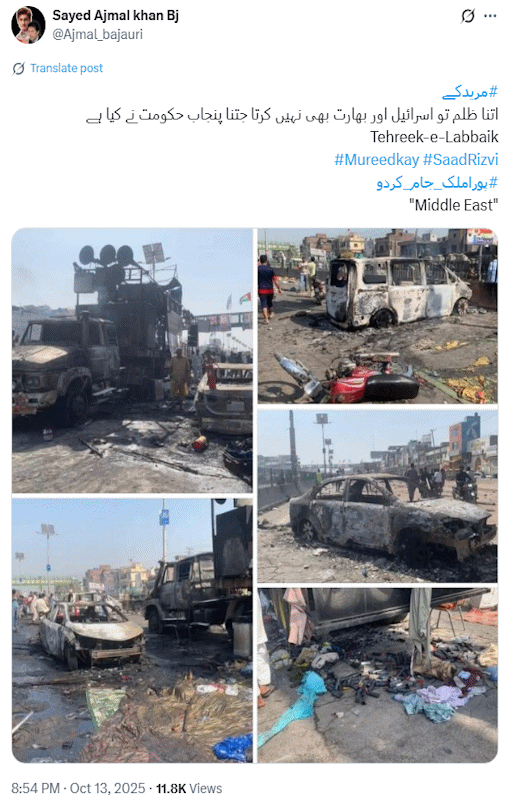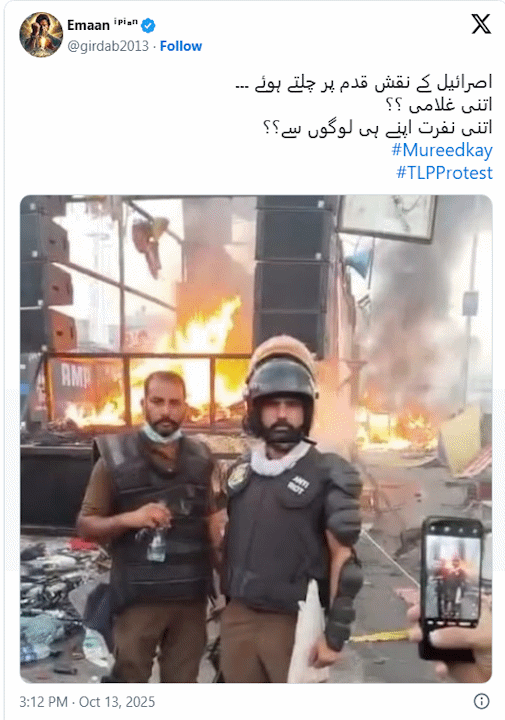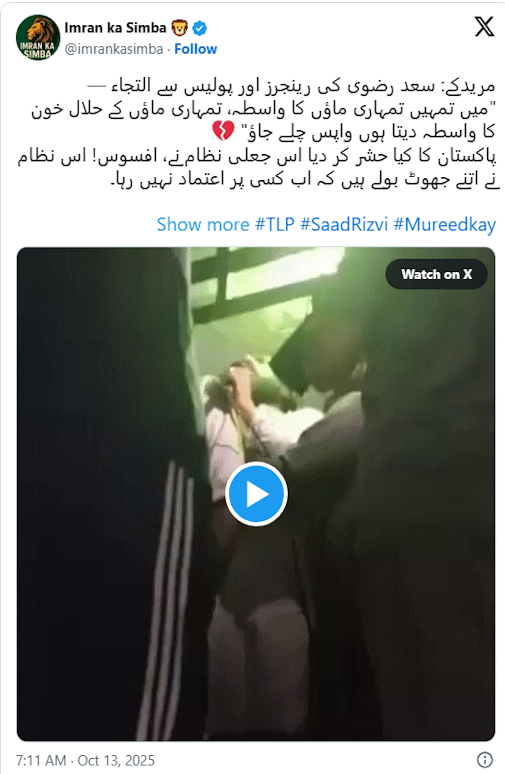The October 13 Muridke incident has left Pakistan shaken once again. The violent clashes between security forces and supporters of Tehreek-e-Labbaik Pakistan (TLP) turned a planned religious procession into one of the deadliest confrontations since the Faizabad sit-in.
What unfolded in the small Punjab town was more than a law-and-order breakdown; it revealed Pakistan’s deepening struggle with non-state actors, political repression, and the dangerous overlap of religion and power.
Social media platforms flooded with graphic videos and sharply divided opinions. In response to the escalating online unrest, the government temporarily blocked access to Twitter (X), citing national security and “digital incitement.”
A panic-like atmosphere soon engulfed the social media platforms with videos of graphic nature, sharply dividing opinions among subscribers. With the online unrest growing to alarming proportions, the government temporarily suspended the operations of Twitter (technically known as X) for purposes of “national security and digital incitement.”
Background
Tehreek-e-Labbaik Pakistan (TLP) is rooted in Pakistan’s Barelvi movement, representing a large segment of the country’s Sunni Muslim population. Its rise began after the execution of Mumtaz Qadri in 2016 an event that transformed Khadim Hussain Rizvi from a fiery cleric into a national figurehead for religious activism.
Under his son, Saad Rizvi, the group evolved into a structured political force capable of mobilizing thousands across Punjab and Karachi.
The group has faced repeated bans for violent protests but continues to command substantial street power. Its followers consider themselves defenders of faith, while the state views them as a recurring security challenge.
Political Context
The Punjab government, led by Chief Minister Maryam Nawaz, now faces sharp criticism over its handling of non-state actors.
Observers argue that her administration’s approach has been increasingly uncompromising, with some analysts drawing comparisons between her leadership and India’s Indira Gandhi both known for using heavy-handed tactics against domestic dissent.
Maryam’s critics recall that the execution of Mumtaz Qadri took place under her father, former Prime Minister Nawaz Sharif, while her uncle Shehbaz Sharif’s government oversaw the Model Town tragedy, where police opened fire on supporters of Tahir-ul-Qadri’s movement in 2014.
There are some unpleasant questions raised by these historical parallels about how the Sharif political dynasty deals with public agitation.
Under Imran Khan, similar standoffs with the TLP were settled in talks. His administration opted for negotiations instead of confrontation. In contrast, the Muridke episode reflects the return of state coercion over political accommodation.
The Muridke Clashes
According to early reports, Saad Rizvi had submitted a written request to organize a peaceful march in solidarity with Palestine. The Punjab government denied permission, citing security threats and regional instability. On October 13, the group proceeded with its plan, resulting in clashes that quickly spiraled out of control.
The FIR registered by police alleged that Saad Rizvi opened fire on the Factory Area Station House Officer (SHO), injuring him.
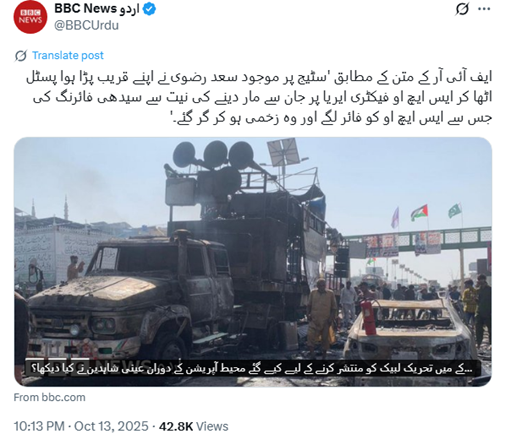 Figure 1: Screenshot of BBC Urdu’s tweet about the FIR report against Saad Rizvi (October 13, 2025).
Figure 1: Screenshot of BBC Urdu’s tweet about the FIR report against Saad Rizvi (October 13, 2025).
Source: BBC Urdu on X (Twitter)
Translation of Urdu: “According to the FIR text, Saad Rizvi, present on the stage, picked up a pistol lying nearby and fired directly at the Factory Area SHO with the intent to kill. The SHO was hit and fell injured.“
The Punjab Police, through their official account, honored the slain officers, calling them martyrs who “sacrificed their lives to protect peace.
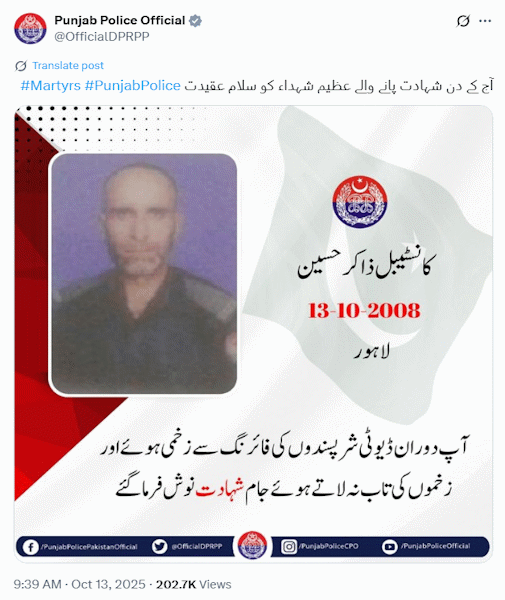 Figure 2: Screenshot of Punjab Police Official’s tribute tweet on Martyrs Day (October 13, 2025).
Figure 2: Screenshot of Punjab Police Official’s tribute tweet on Martyrs Day (October 13, 2025).
Source: Punjab Police Official on X (Twitter)
Translation of Urdu: “Heartfelt salute to the great martyrs who embraced martyrdom on this day.”
(Hashtags: #PunjabPolice #Martyrs)
Witness videos circulating online, however, showed men in plain clothes firing at demonstrators, sparking accusations of extrajudicial violence.
Social media erupted with polarized reactions some defending law enforcement, others accusing the state of using “Israel-style” force against its citizens.
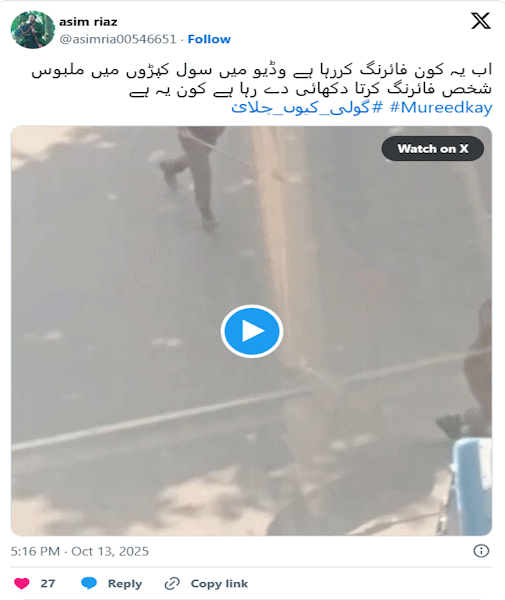 Figure 3: Screenshot of Asim Riaz’s video tweet questioning the identity of a person firing during the Mureedkay protests (October 13, 2025).
Figure 3: Screenshot of Asim Riaz’s video tweet questioning the identity of a person firing during the Mureedkay protests (October 13, 2025).
Source: Asim Riaz on X (Twitter)
Translation of Urdu: “Who is firing now? In the video, a person dressed in civilian clothes is seen firing. Who is this?”
#Mureedkay #WhyWasTheBulletFired
Figure 4: Screenshot of Sayed Ajmal Khan Bj’s tweet condemning government actions in Mureedkay (October 13, 2025).
Source: Sayed Ajmal Khan Bj on X (Twitter)
Translation from Urdu: “Even Israel and India do not commit the kind of oppression that the Punjab government has carried out.
Tehreek-e-Labbaik #SaadRizvi #Mureedkay #ShutDownTheWholeCountry”
Figure 5: Screenshot of Emaan ⁱᴾⁱᵃⁿ’s tweet criticizing government actions in Mureedkay (October 13, 2025).
Source: Emaan ⁱᴾⁱᵃⁿ on X (Twitter)
Translation of Urdu: “Following in Israel’s footsteps…
So much slavery??
So much hatred towards your own people??
#Mureedkay #TLPProtest”
Amid this, a viral video showed Saad Rizvi pleading with police and Rangers to step back, saying, “I beg you in the name of your mothers’ honor, please return.”
Figure 6: Imran ka Simba’s video tweet about Saad Rizvi’s plea during Mureedkay protests (October 13, 2025).
Source: Watch full video on X (Twitter)
These conflicting visuals deepened the uncertainty about who fired first and how a religious procession became a battlefield.
Public Reaction and Media Divide
The Twitter (X) ban manifests how volatile the digital narrative has become. TLP supporters termed it as a “massacre,” while government spokespersons emphasized “terrorist provocation.” Strong clerics and journalists further circulated unverified videos, intensifying one’s vent.
Muhammad Raza Saqib Mustafai’s sharing of “Muslims killed by Muslims” became the most popular among the public, reflecting the exhaustion of the public from the never-ending cycle of violence.
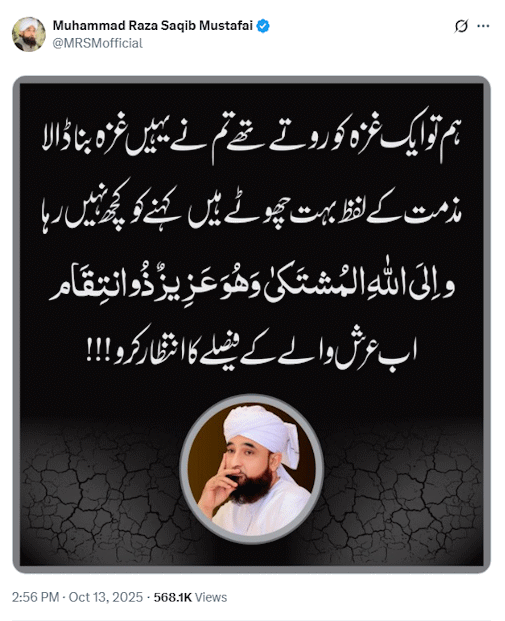 Figure 7: Screenshot of Muhammad Raza Saqib Mustafai’s tweet expressing anger and grief over events in Mureedkay (October 13, 2025).
Figure 7: Screenshot of Muhammad Raza Saqib Mustafai’s tweet expressing anger and grief over events in Mureedkay (October 13, 2025).
Source: Muhammad Raza Saqib Mustafai on X (Twitter)
Translation of Urdu: “We used to weep for a Gaza; you have made a Gaza right here.
Words of condemnation are far too small — there is nothing left to say.
‘To Allah is the complaint, and He is Mighty, Owner of Retribution.’
Now wait for the judgment of the One on the Throne!!!”
Others, such as journalist Shafeeq Khan, accused state institutions of tampering with evidence, a claim that reignited memories of the unresolved Model Town and Liaquat Bagh incidents.
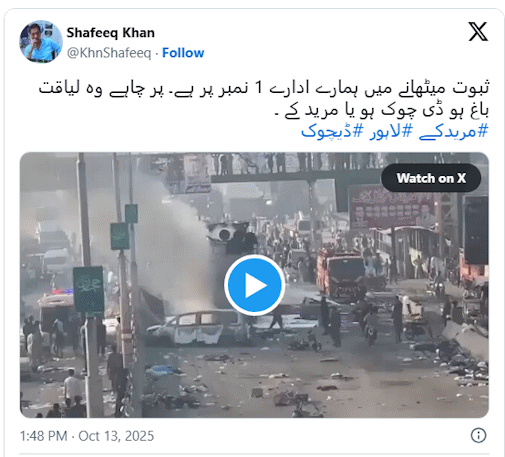 Figure 8: Screenshot of Shafeeq Khan’s video tweet highlighting institutional presence at protests in Mureedkay, Lahore, and D-Chowk (October 13, 2025).
Figure 8: Screenshot of Shafeeq Khan’s video tweet highlighting institutional presence at protests in Mureedkay, Lahore, and D-Chowk (October 13, 2025).
Source: Shafeeq Khan on X (Twitter)
Translation of Urdu: “Our institutions are number one when it comes to gathering evidence. Whether it is Liaqat Bagh, D-Chowk, or Mureedkay.”
#Mureedkay #Lahore #DChowk
The polarized media response once again highlighted Pakistan’s fragile trust in its own institutions.
The Role of Non-State Actors
The Muridke incident also underscores the persistent challenge of non-state actors in Pakistan’s internal landscape. TLP, while registered as a political party, operates through street power, symbolism, and emotional mobilization blurring the line between activism and militancy.
Security analysts argue that while the state fights armed groups in Balochistan, Bajaur, and along the Afghan border, it faces a different kind of challenge in Punjab, one born from within the religious mainstream, not the periphery.
The government’s dilemma is complex to tolerate these groups and risk radicalization, or suppress them and invite further martyrdom narratives. Neither path has yet worked.
Broader Implications
The Muridke tragedy shows how Pakistan’s struggle with non-state actors continues to destabilize its politics and society. The repeated use of force whether in Model Town, Faizabad, or now Muridke has eroded public confidence in democratic conflict resolution.
With both police officers and TLP supporters killed, Pakistanis once again face the moral paradox of defining “martyrdom” within internal conflict. For many, it is no longer about ideology or allegiance it is about the cost of being trapped between two powers that claim to act for the nation’s survival.
The post Faith, Fear, and Fire: The Muridke Massacre and the Struggle with Non-State Actors first appeared on Dissident Voice.This post was originally published on Dissident Voice.
